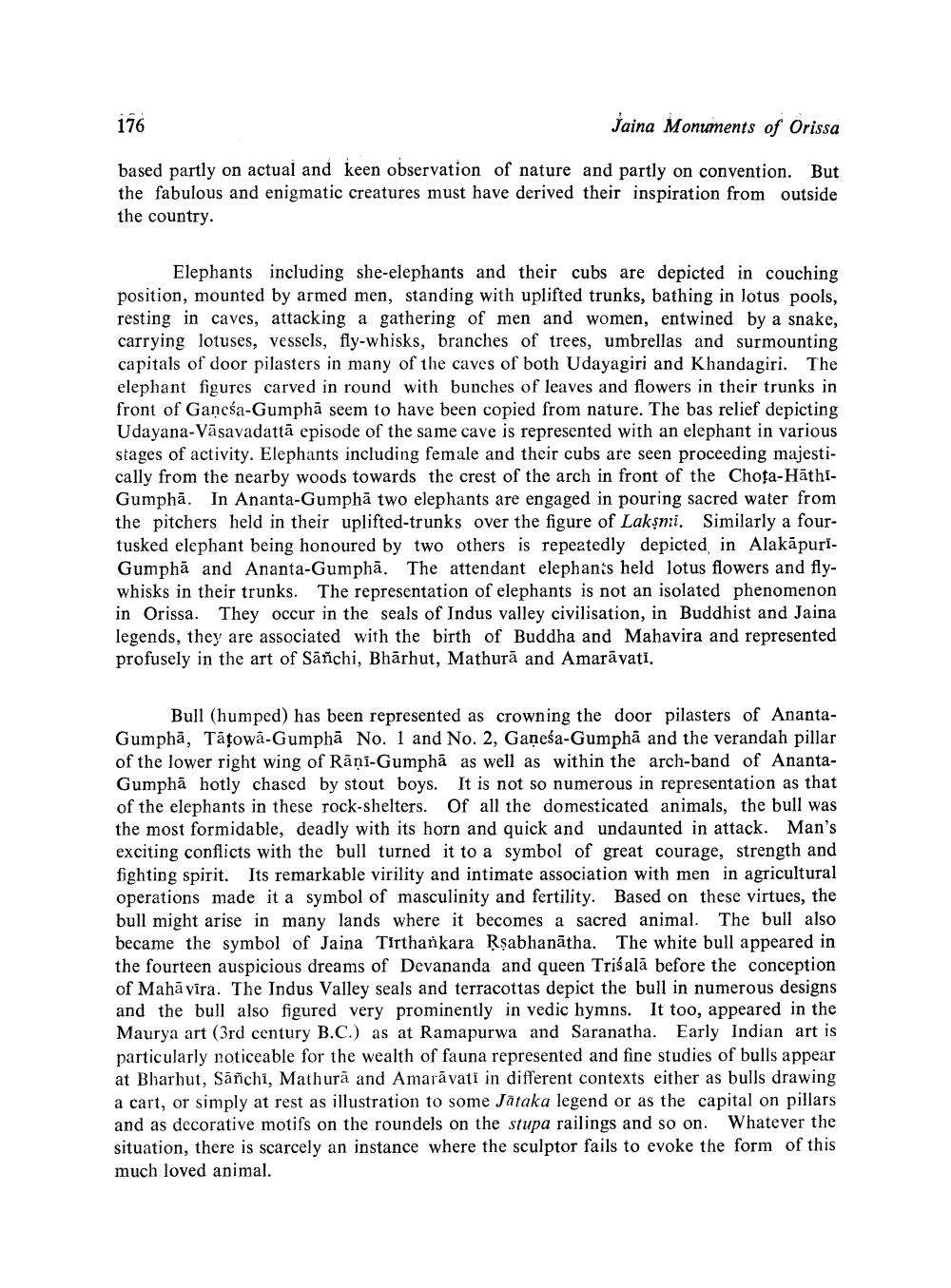________________
176
Šaina Monuments of Orissa
based partly on actual and keen observation of nature and partly on convention. But the fabulous and enigmatic creatures must have derived their inspiration from outside the country.
Elephants including she-elephants and their cubs are depicted in couching position, mounted by armed men, standing with uplifted trunks, bathing in lotus pools, resting in caves, attacking a gathering of men and women, entwined by a snake, carrying lotuses, vessels, fly-whisks, branches of trees, umbrellas and surmounting capitals of door pilasters in many of the caves of both Udayagiri and Khandagiri. The elephant figures carved in round with bunches of leaves and flowers in their trunks in front of Ganesa-Gumphā seem to have been copied from nature. The bas relief depicting Udayana-Vāsavadattā episode of the same cave is represented with an elephant in various stages of activity. Elephants including female and their cubs are seen proceeding majestically from the nearby woods towards the crest of the arch in front of the Choța-HathiGumphā. In Ananta-Gumphā two elephants are engaged in pouring sacred water from the pitchers held in their uplifted-trunks over the figure of Laksnii. Similarly a fourtusked elephant being honoured by two others is repeatedly depicted in AlakāpuriGumphā and Ananta-Gumphā. The attendant elephants held lotus flowers and flywhisks in their trunks. The representation of elephants is not an isolated phenomenon in Orissa. They occur in the seals of Indus valley civilisation, in Buddhist and Jaina legends, they are associated with the birth of Buddha and Mahavira and represented profusely in the art of Sāñchi, Bhārhut, Mathurā and Amarāvati.
Bull (humped) has been represented as crowning the door pilasters of AnantaGumphā, Tätowa-Gumphā No. 1 and No. 2, Ganesa-Gumpha and the verandah pillar of the lower right wing of Rāņi-Gumph, as well as within the arch-band of AnantaGumphā hotly chased by stout boys. It is not so numerous in representation as that of the elephants in these rock-shelters. Of all the domesticated animals, the bull was the most formidable, deadly with its horn and quick and undaunted in attack. Man's exciting conflicts with the bull turned it to a symbol of great courage, strength and fighting spirit. Its remarkable virility and intimate association with men in agricultural operations made it a symbol of masculinity and fertility. Based on these virtues, the bull might arise in many lands where it becomes a sacred animal. The bull also became the symbol of Jaina Tirthankara Rşabhanātha. The white bull appeared in the fourteen auspicious dreams of Devananda and queen Trisalā before the conception of Mahā vira. The Indus Valley seals and terracottas depict the bull in numerous designs and the bull also figured very prominently in vedic hymns. It too, appeared in the Maurya art (3rd century B.C.) as at Ramapurwa and Saranatha. Early Indian art is particularly noticeable for the wealth of fauna represented and fine studies of bulls appear at Bharhut, Sāñchi, Mathurā and Amarāvati in different contexts either as bulls drawing a cart, or simply at rest as illustration to some Jataka legend or as the capital on pillars and as decorative motifs on the roundels on the stupa railings and so on. Whatever the situation, there is scarcely an instance where the sculptor fails to evoke the form of this much loved animal.




